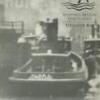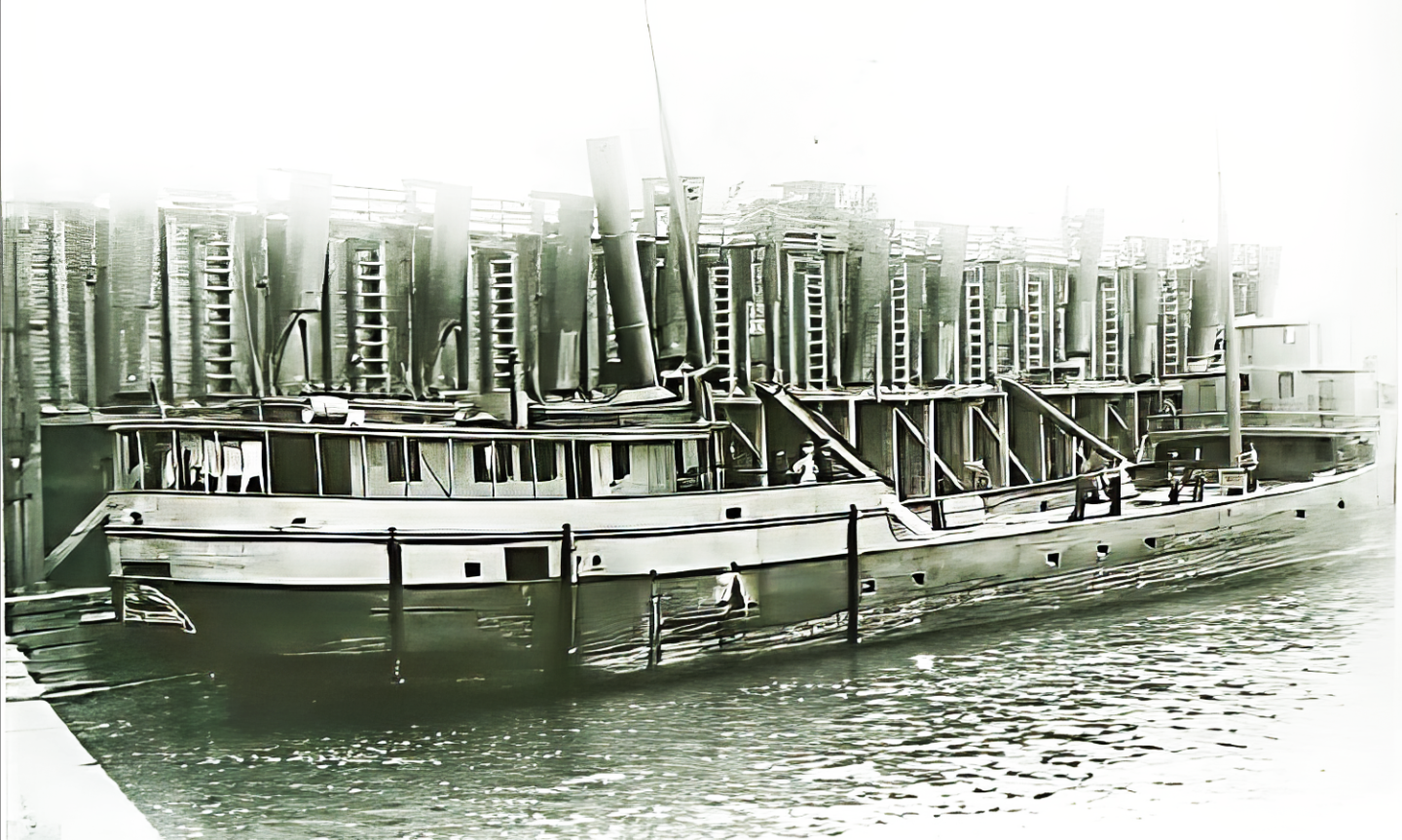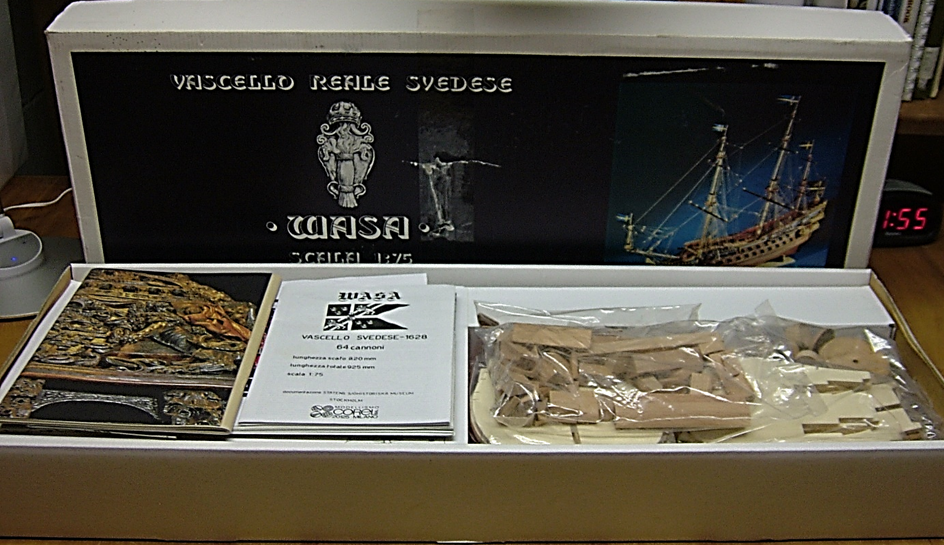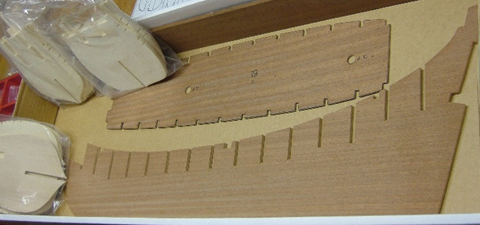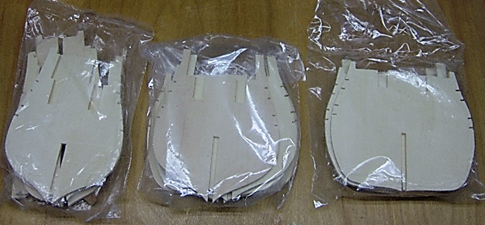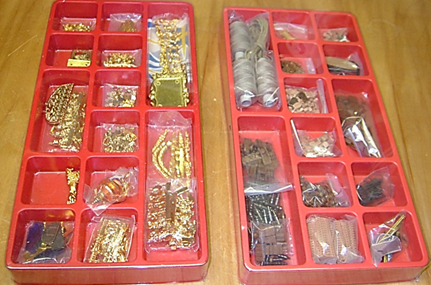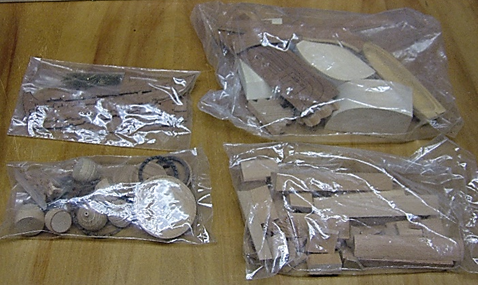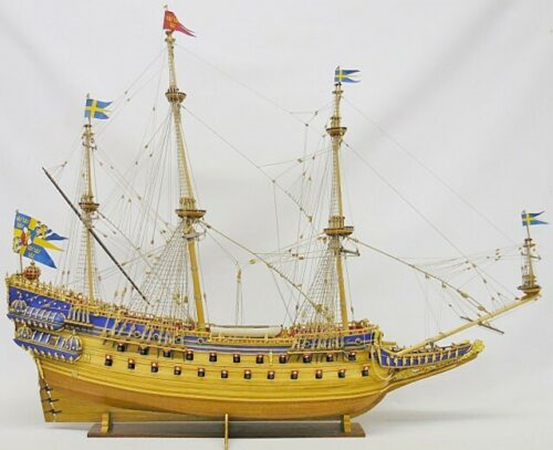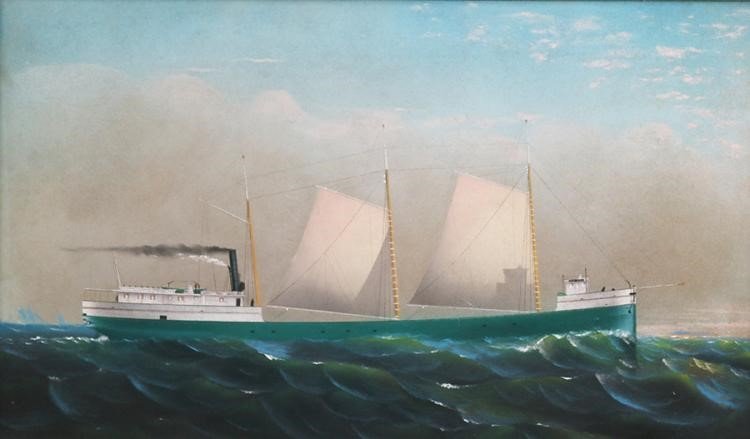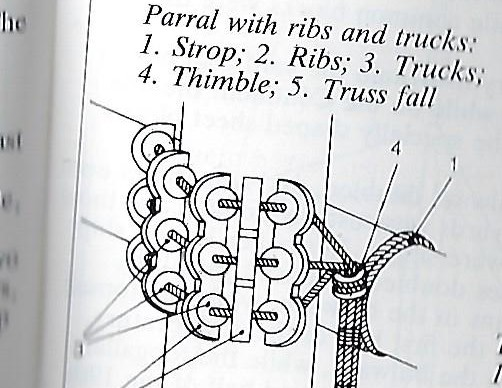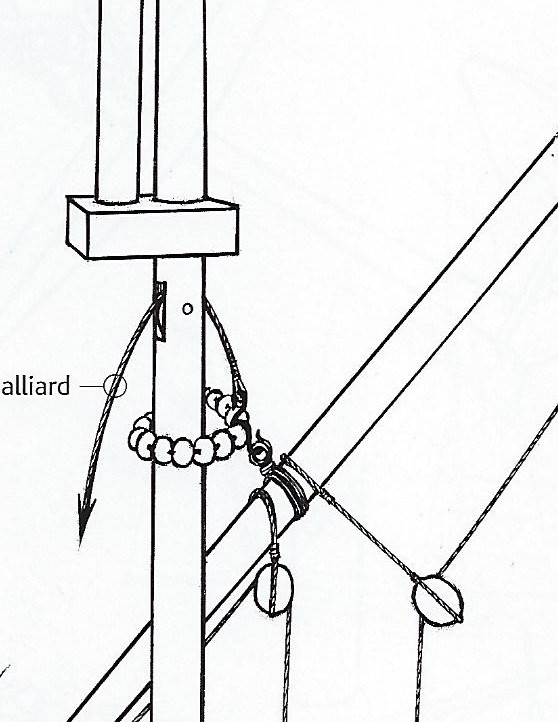-
Posts
59 -
Joined
-
Last visited
Content Type
Profiles
Forums
Gallery
Events
Everything posted by Feathermerchant
-
Thanks for your input. I have two sets of plans that I am using for a reference. One is A.J. Fishers "Huron Brave", which is a Great Lakes bulk wooden steamer that never existed, and the other is the Smithsonian WPA plans for the wooden steamer from 1890 "Sidney O. Neff." Neither show the details for the hatch covers. The Neff drawings show a partial crosshatch drawing on the hatch cover, displaying the end grain of the wood pieces that make up the hatch cover. The grain runs fore and aft, but does not show whether the hatch cover is one or more sections. Converting the plan dimensions for the hatch covers shown for the Neff, they are: fore: 8' x 8', mid: 8' x 13' 7 aft: 8' x 10'. The Huron Braves drawing shows the hatch covers 8' x 16'. In the photo, the hatch covers are leaning against a 4 foot high bulwark. Using that as a reference, the hatch cover shown is a 6'x 4' section and that the hatch opening is 6' x 8'. That is based upon the assumption that the other halve of the hatch cover is leaning against the starboard bulwark. By the way, what looks like damage to the starboard side of the hull is, Photo Shop handling of a engine draining pipe and the discoloration caused by waste water on the side of the hull. Thanks for your help and Roger, good thread on your build.
-
Interesting. Could you drop back 125 years and describe the hatches used on steambarges hauling stone? i am building a model of the steambarge Margaret Olwill based upon the only known photo (see below). This was taken on June 27th, 1899 of her as she sat at the stone loading dock on Kelly's Island, Lake Erie. . She loaded limestone that day, left for Cleveland at midnight (50 mile trip) to be off Cleveland early June 28, 1899. Ran into a Nor'Easter, off Lorain, Ohio, broke her steering chain, cargo shifted and rolled over sinking 8 miles off Lorain. Nine lives lost, including her captain, his wife, son and a guest, as well as five of her nine crew. The wreck was located in 2017. Two hatch cover can be seem leaning against the port rail. Note: There are no plans of vessel. Model is built from this photo and similar steambarges of the timeframe.
-
The WASA, a royal Swedish vessel with 64 guns sank in the waters around Stockholm on the day it was launched (10 August 1628) as the result of a violent gust of wind. The ship settled in 35 m of water. Construction on the vessel started in 1625, under the direction of the Dutch architect Henrik Hybertsson. While some guns and a few other objects had been recovered earlier, it was only possible to bring the ship to the surface in 1956. Partially rebuilt and restored, the WASA was installed in the Wasa Museum in Stockholm in 1958.Our reproduction of the WASA is based on the excellent graphic reproductions published by the Board of the Museum. Corel's Wasa wooden model ship kit includes more than 350 gilded cast metal decorations designed by sculptor V. Marino of Milan. 64 turned brass canon barrels, fittings in walnut, beech, copper and brass. Hull is double-planked in basswood and walnut. Includes 9 large sheets of plans and step-by-step instructions. This advanced kit is for those who are looking to build a masterpiece of a model. The kit is being sold by a club member from Phoenix, AZ. Retired but due to medical issues and downsizing to smaller housing, he is selling this kit at half its original value. The kit has been opened but all parts and supplies are in their original containers. There is damage to the box cover, but no damage to interior content. Price does not included shipping. Weight of kit: 10.0 lbs. UPS Ground (Ohio – California) = $75.00; includes: $7 packing; $11 Insurance. First post with "I'll take it" will be contacted.
-
Beautiful model. Where are you located? My reason for asking is, the President Rutherford Hayes Presidential Library at Fremont, Ohio is looking for a model of either the HMS Resolute or HMS Terror for an exhibit that will run from March 2023 to June 2024. Kevin Moore, is the curator with the Rutherford B. Hayes Presidential Library & Museums in Fremont, Ohio. They are currently working on an exhibit on the history of arctic exploration in the 19th century. President Hayes received the Resolute Desk from Queen Victoria, which has been used by nearly every president since Hayes. The Resolute Desk was constructed from the timbers of the HMS Resolute, the ship that was dispatched to search for the lost Franklin Expedition. Their upcoming exhibit will use that connection as an opportunity to explore the broader maritime history of the arctic. If you are open to sharing your model with the Hayes Presidential Library for a year, let me know and I will have the curator contact you. Thanks...........................bill
-
Roger, I agree with you on the life of wooden ships on the Great Lakes. The Margaret Olwill was built in 1887 as a steambarge, rebuilt in 1890 as a propeller and in 1893 returned back to a steambarge. From my research to date, from launch in 1887 to her sinking in 1899, she was owned and operated by L.A. & J.A. Smith, Cleveland and they appear to be in the construction, excavation business. I have found legal documentation that reference work in 1892 (proposals for work at the mouth of the Detroit river, a contract in writing was entered into December 31, 1892, by O. M. Poe, Colonel, Corps of Engineers, U. S. Army, and appellees, by which the latter agreed to excavate a ship channel 20 and 21 feet deep, located in section 8 of the Detroit River. They won in court.) The Smith Co. owned land on the Cuyahoga River where the Margaret Olwill was built. It appears the vessels were used to haul building supplies and rock. The contract that the Olwill was providing limestone for was the breakwall being built for the Cleveland harbor. In my research work I have found that the life of a wooden vessel, if they lasted, went from a sidewheel steamer or propeller to sail and then to a barge for hauling bulk materials or for storage.
-
Roger, thanks for the lead. It is good to see another picture of the M. Olwill. My picture, taken the day before she sank, does not have that third mast on the cargo deck. The stern house matches the photo and I now have a side view of the pilot house. I also painted the hull the same color the artist did. Good guess on my part. Thanks again, and have a great Thanksgiving.
-
Roger, checked the personnel records at Bowling Green State University, Historical Collections of the Great Lakes and found the following: Pellet, ???; Mansfield, 1899 Historical Collections of the Great Lakes Personnel Pellet, ??? Pellet, ???; Mansfield, 1899 Record Name Pellet, ???; Mansfield, 1899 Person Record For Pellet, ??? Position Position Date 1867-00-00 Position Captain Vessel Vessel Name KING SISTERS Vessel Type schooner Source Source Mansfield, 1899 Source Date 1899-00-00 There is no listed as Pellett. The record shows an individual, last name Pellet, was found in a Mansfield source in 1899 that was a captain of a schooner "King Sisters" in 1867. Checked the research of C. Patrick Labadie at Alpena County George N. Fletcher Public Library and found that history of the schooner "King Sisters" 1862 Enrolled Toledo. 1863 Owned Lyon & Sherman, Cleveland, OH. 1863, Aug Damaged cargo. 1866 Owned L.L. Lyon, Cleveland. 1866, Jun Collision, Straits of Mackinac. 1868 Readmeasured 286.75 gross tons, official number US14039. 1869, Oct Dismasted, Lake Erie. 1871 Owned Mrs. L.L. Lyon, Cleveland; repaired, new deck. 1871, Jul Collision with bark MONITOR, St. Mary's River. 1871, Aug 24 Aground Point Pelee, Lake Erie with schooner DELAWARE. 1874 Repaired. 1874, Aug Aground False Presqu'Isle, Lake Huron with pig iron. 1876 Owned Burgess, Cleveland. 1879 Owned Lyon Estate, Cleveland. 1881 Extensive repairs, new keel, stem, stern post, rudder, planking, new running gear. 1884, Oct 19 Wrecked, Lake Erie. The schooner "King Sisters" was built for the King Brothers, Toledo, by Smith and Rogers, Toledo. She wrecked on Gull Island Sholl, was an island north of Sandusky and the Marblehead Peninsula 120 years ago and is now submerged.
-
"For every cargo that can be conceivably be carried aboard ship there is what’s called a “stowage factor” that lists the volume required by one ton of cargo. The principal American Great Lakes cargo was and still is iron ore. In the early 1900’s, coal was a secondary cargo, loaded when the opportunity presented to avoid returning back up the Lakes in ballast. The stowage factor for iron ore, a very heavy cargo, is about 20 cu ft per ton. When hauling iron ore the ship would be considered to be fully loaded well before her holds were full. Sacrificing hold volume for bunker space, therefore, did not affect the carrying capacity for vessels built to haul iron ore." Roger, I am building the Great Lakes steam barge Margaret Olwill. She ran between Cleveland and Kelly's Island on Lake Erie hauling crushed limestone from the island's quarry's. Built in 1887, 175'7" x 35' x 10.2'; 542 grt, she sank in a storm returning to Cleveland, June 28, 1899, with a loss of 8 lives. The wreck was discovered in 2017 8 miles out from the port of Lorain. My question has to do with her cargo. The write-up state she loaded 300 tons into her hold and had another 600 tons on her deck. How would I compute the actual "Stowage Factor" for her?
-
Sean, it has been a long two years. We will restart in-person meetings at the Westerville Library, Saturday, September 18th, 2021. Will be doing a joint Zoom/In-person session. We gather at 9 AM and the meeting starts at 9:30. If you cannot make our meeting but would like to join on Zoom, send me your email address to shipwright@wowway.com. You can also go to our home page at shipwrightsofohio.com and click on the meeting heading at the top of the page, which should connect you to our "green Room" on Zoom.
-
Roger, interesting blog. The CD file of the American Ship Building (ASB) Drawings were an outcome of a three year project that a member of our ship modeling club and I did at the Inland seas Museum, Vermilion. ASB donated all their ships drawings, including their predecessors, to Bowling Green State University (BGSU), Great Lakes Historical Society and the Dossin museum in Detroit. Prior to distributing the plans, BGSU microfilmed all the plans and has them on file. Those plans covered a period from 1867 - 1920. They released that catalog in 1988, and I do not think it has been reprinted. When we completed our work, we also contacted all the maritime museums around the Great Lakes and recorded their ship plan holdings. the only museum that did not participate was the Dossin. I have had a copy of two Great Lakes ships that have been on my "To Do" list since that project ended in 2005. The lumber hooker "Sidney O. Neff" and the Great Lakes tug "Edna G". I also have the A.J. Fisher plans for the "Huron Brave", which is a composite of different "Lumber Hookers" and is has never been a real ship. though it is very good looking. I got my plans out on the drawing board and wondered what was available on MSW. That is how I got here. It will be interesting watching your build. Did you carve your hull out of a solid wood block or in a "bread & butter" style? Bill
-
Steven, I purchased digitized photos of the Great Harry from the Powerhouse Museum. They are TIFF format so I can do closeups of the rigging. The futtock shrouds are attached either to a wire or tightly tied line just under the lip of the crow's nest lip and then tied off on the shrouds below. I had talk to Harry Gee, Rights and Permission Officer for MAAS. He told me that they were digitizing the photos of the Great Harry. Received them last week and have been using the photos to draw out the standing rigging. It is like having a magnifying glass while looking at a large model. I have in another screen the crow's nest with futtock shrouds taking up the whole screen. Great for detail and really helps in understanding how the model was rigged.
- 71 replies
-
- great harry
- henry grace a dieu
-
(and 3 more)
Tagged with:
-
Steven, I have Anderson. Finished reading Mark Myers, masters thesis "The Evolution of Hull Design in Sixteenth-Century English Ship-Of-War" (Texas A&M). Henry VII (early 1500's and Elizabeth (Late 1500's) were the major builders of English ships and both changed the hull designs but appears that there was not that much change in rigging. That said, Anderson wrote his book in 1883 based on source materials from the 16-1700's. I am going to assume that the rigging of ships in Henry's VIII's time did not change that much by the early 1600's. Since I have now a starboard view of the Auz. model, I should be able to draw out the rigging plan for "The Great Harry" when the model was built. This is a restoration back to how it looked 60 years ago with the exception of how the yards were fastened to the masts. The model, when we picked her up, had the yards wired to the masts and the owner asked if we could replace the wire with rope. That said, Anderson becomes our technical source for how to rig a 1600 vessel since I have not found a technical source for the 1500's.
- 71 replies
-
- great harry
- henry grace a dieu
-
(and 3 more)
Tagged with:
-
Keith, thats is a good question and we do not have a crisp answer. Family says it came to America with a great grandfather when he emigrated either before or around the turn of the century from Germany. The Powerhouse Museum dates it at 1920's but does not know the maker. NMM, Greenwich dates theirs as possibly early 19th C. reconstruction, based upon an engraving published in 1756. That is a 100 year span and raises the question: Who and where? We have three models, America, UK, & Aus. that are almost identical. What we do know is that our model has a plaque in the keel that has Germany on it. I expect that we have the same craftsman duplicating the mode. In this mix we have the Great Exhibition of 1851 (Crystal Palace), in Hyde Park, London where a model of the "Great Harry" had been made for display. The Crystal places was moved to south London in 1854 and stood until 1936 when it was burned down. So the question is: Is the Great harry in the US & Aus. a one-off to the Great Harry at NMM and did a local guild in Germany build the models for sale?
- 71 replies
-
- great harry
- henry grace a dieu
-
(and 3 more)
Tagged with:
-
Uff Da, Forgot to note that the rigging of the Lateen Yard is from Lennarth Petersson's "Rigging Period Fore-and-Aft Craft, French Lugger (page 63).
- 71 replies
-
- great harry
- henry grace a dieu
-
(and 3 more)
Tagged with:
-
I will now confine my comments to this build log rather then my own. My focus is trying to understand and draw the rigging plan for our model. We have three models to study to understand how she was rigged (NMM, Greenwich - rigging in bad shape; Our model - rigging mostly removed before we took possession; and the model at the Powerhouse Museum, Sidney.) The Powerhouse Museum had two photos of their model, one from the port side (shown above) and one from the starboard side, showing how she is rigged. I signed all the papers to get a copy of the models starboard side this morning. The owner stipulated that she want the vessel rigged as it was with one exception: How the yards are fastened to the masts. In the model when we received it, the yards were wired to the masts. the owner has asked us to replace the wire with rope. The above worked from the 13th to 18th C. (Mondfeld). Mondfeld, Deane's and Steel mention lateen yards but not how they are held to the mast Rigged as above would allow the Lateen yard to swing with the wind without binding and also allow the yard to be lowered to the deck. Though 18th C., I doubt that rigging a lateen yard had not changed in 200 years.
- 71 replies
-
- great harry
- henry grace a dieu
-
(and 3 more)
Tagged with:
-
Louie da fly I have contacted the Museum of Applied Arts and Sciences (MAAS) in Sidney, the Photo Library, about the photo they have posted of "Great Harry" H 3476. Harry Ree wrote back with a photo of the Great Harry from the starboard side of the model, showing more details of her rigging. It is not of the best quality. They will provide a new digital photo. but due to Covid-19 and other priorities it could take 6-8 weeks. Without plans available, this may be the only way we can duplicate the rigging on our model. Appreciate your help and that the museum is the "Powerhouse" that holds the model. From their web site I found the reference to the Photo Library and their contact information. Thanks again.
- 71 replies
-
- great harry
- henry grace a dieu
-
(and 3 more)
Tagged with:
-
Nemo, "A shipmodeling Club is a Modeler's Most valuable Tool". That said, I have included below, the list of ship modeling clubs for the NRG list that are in AB & BC. Below that is a list from found on the Internet of R/C clubs in AB. Model Ship World is a helpful source when you feel isolated, but have a fellow ship modeler that you can share a cup of coffee with and your frustrations with your build is also. .................feathermerchant - Shipwrights of Central Ohio. www.shipwrightsofohio.com. Calgary, AB Calgary Model Boat Racing Association 42 Armstrong Cres. S.E. Calgary, AB Burnby, BC Burnaby Association of Marine Modelers John Tarvin 5209 Rumble Street Burnaby, BC Parksville, BC Parcum Mariners Model Boat Club Nisbet P. Patfield 78 Magnolia Drive Parksville, BC Victoria, BC Victoria Model Shipbuilders Society 4996 Georgia Park Terrace Victoria, BC Website: members.shaw.ca/VMSS Email: vmss@shaw.ca Calgary Calgary Model Boat Racing Association 42 Armstrong Cres. S.E. Calgary, Alberta T2J 0X3 Edmonton Edmonton Model Boat Racing Association 8719 160 St. Edmonton, Alberta T5R 2H4 (403) 483-8392 Spruce Grove The Alberta Ship Model Society #205, 211 Church Road, Spruce Grove, Alberta T7X 3J8
-
I have been contacted about a partial built model that dates from the mid-30's. The information given is: "A 32" wooden sailing ship hull, including some rigging. The model was probably started in the early to mid thirties by my dad's best friend. Probably not completed because of WWII. Given to the individual in the early 60's. Other than a feeble attempt, nothing has been done with it for 55+ years". It looks like a 24-gun, possible a frigate, solid hull. Since it dates to the early, mid-30's there were few model ship kit makers so does anyone know of either a kit that was available back then or is this a model started from Popular Science/Mechanic plans run in their magazine? Can anyone help in solving this mystery?
-
Sean, Welcome. Sorry you missed Saturday's meeting. Our next meeting will be Saturday, April 21st in the conference room. Follow the directions you have for the classroom, but when you pass the gift shop, take a right and then a second right and the conference room is at the end of the short hallway behind the gift shop. If you send me your contact info, I will send you a reminder and our March newsletter "Ropewalk". The club contact is shipwright@wowway.com. Again, welcome aboard. Bill Nyberg president Shipwrights of Central Ohio
-
Thanks for the information & suggestions. The model Dapper Tom and Model Shipways kit and this model were built for a non-existent ship. I found an article on a capstan for the Victory by Glen Greico, Texas A&M showing lifting an anchor using messenger & nippers with the storing of the anchor cable through a hatch aft of the riding bitts. It also showed the capstan aft of the main mast. Checking my pictures of the forward deck of a Baltimore Clipper, I found rollers that the messenger cable would have been used to guide it to the anchor cable. The deck layout on the Dapper Tom has the capstan aft of the main mast so I improvised and placed two small openings in the deck between the riding bitts and the foremast. I have attached the picture of the capstan from Grieco's Victory. Capstan.docx
-
I am in the process of restoring the Baltimore Clipper "Dapper Tom" a fictitious model of an 1815, 8-gun schooner. I have a copy of Model Shipways plans, copyright 1954, and the instruction manual for this model, copyright 2006. I was ask to repair/restore the model after it took a header off a shelf and broke most of the rigging. The original model dates from the 1960's. The original anchor line, stowed on deck, is 5/32" diameter. Scale of the model is 5/32" = 1'. I plan to reduce the size of the anchor line to 1/32" (3" dia.) but I cannot find the access to the anchor line locker. I cannot believe that they would store all that rope on the deck. I was thinking of two holes in the deck near the riding bit. Can anyone help me on how this was done. I have checked Chapelle's "The Baltimore Clipper" . No help.
About us
Modelshipworld - Advancing Ship Modeling through Research
SSL Secured
Your security is important for us so this Website is SSL-Secured
NRG Mailing Address
Nautical Research Guild
237 South Lincoln Street
Westmont IL, 60559-1917
Model Ship World ® and the MSW logo are Registered Trademarks, and belong to the Nautical Research Guild (United States Patent and Trademark Office: No. 6,929,264 & No. 6,929,274, registered Dec. 20, 2022)
Helpful Links
About the NRG
If you enjoy building ship models that are historically accurate as well as beautiful, then The Nautical Research Guild (NRG) is just right for you.
The Guild is a non-profit educational organization whose mission is to “Advance Ship Modeling Through Research”. We provide support to our members in their efforts to raise the quality of their model ships.
The Nautical Research Guild has published our world-renowned quarterly magazine, The Nautical Research Journal, since 1955. The pages of the Journal are full of articles by accomplished ship modelers who show you how they create those exquisite details on their models, and by maritime historians who show you the correct details to build. The Journal is available in both print and digital editions. Go to the NRG web site (www.thenrg.org) to download a complimentary digital copy of the Journal. The NRG also publishes plan sets, books and compilations of back issues of the Journal and the former Ships in Scale and Model Ship Builder magazines.


